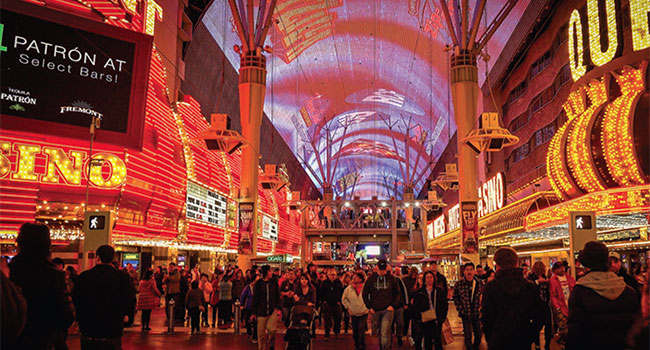
Driving Revenue
How LiDAR is improving security at casinos with flow management
- By Gerald Becker
- Jan 27, 2022
The year 2020 was a challenge for casinos, as lockdowns forced them to close their doors and ultimately cost the gaming industry $18.3 billion in the 2020 fiscal. However, casinos have come back stronger than ever, focused on recouping those losses and then some. LiDAR is playing a key role in the gaming industry’s comeback by providing rich data and insights into how people move throughout the space.
This information not only improves on-site security, ensuring guests have a safe and enjoyable experience, but it also makes it possible to understand customers at a much more granular level to drive engagement–and, ultimately, increase revenue. All this is accomplished without collecting any personally identifying information (PII), and without the high costs of running cabling for hundreds of cameras.
Explaining LiDAR
3D LiDAR sensors emit pulsed light waves into the surrounding environment. These pulses bounce off surrounding objects and return to the sensor, which then uses the time it took each pulse to return to the sensor to calculate the distance it traveled (time-of-flight). This data will create a rich 3D point cloud, which provides incredibly granular detail about the surrounding area–all in real time.
LiDAR technology is commonly used in a wide variety of markets like robotics, terrestrial mapping, autonomous vehicles and industrial IoT. More recently, LiDAR’s unique ability to accurately monitor and track people – completely anonymously – as they move throughout a space has opened up a wide range of possibilities for smart spaces.
How Casinos are Using LiDAR
Casinos are using LiDAR in a few key security and business intelligence applications. Traditionally, these applications are solved with surveillance cameras. However, cameras pose a few disadvantages, including personal identifiable information (PII) risk, high costs, extensive infrastructure requirements, and limitations in their ability to identify objects.
While cameras can still provide significant value, and remain a critical component of many security applications, they are best paired with an intelligent sensing solution like LiDAR sensors that can provide higher accuracy and granular insights. In addition, LiDAR poses no additional PII risk. Unlike cameras, which can capture images and transmit them over the network to other applications, LiDAR captures no personal identifiable information. Instead, LiDAR create a point cloud – or millions of points in a 3D space that together create the silhouettes of moving or fixed objects.
The following are just a few examples of where LiDAR has emerged as a premier solution for security and business intelligence in the gaming industry.
Interior and Exterior Security
Inside of the casino, LiDAR sensors can track the movement within a given space. If a potential threat is suspected, LiDAR sensors can be integrated with PTZ cameras to keep that person in view at all times, while security personnel respond.
Outside of the casino, LiDAR sensors can monitor for potential objects thrown off the roof, or identify people in areas that they should not be in – for example, on rooftops or private areas that are not open to the public.
Crowd Monitoring and People Counting
Unlike cameras, LiDAR can be used to monitor crowds and count occupancy without affecting the flow of people in and out of a space. For example, people counting in large open spaces can be particularly challenging. The casino will need a large network of cameras, which comes with the high infrastructure and cabling costs, or you need to install a turnstile to count each person that enters. However, this hinders free movement, leading to frustrating traffic bottlenecks and posing significant safety risks.
LiDAR sensors, on the other hand, can provide 360-degree coverage and long ranges, monitoring large areas with only a few devices that can be installed virtually anywhere. In addition, LiDAR can provide more than just a tally of people entering and exiting. With the 3D point cloud, LiDAR also lets you see how people are moving throughout the space and understand where they are spending the most time. For example, this data can be used to command higher advertising prices in areas with high traffic and high dwell times.
Tracking Analytics and Insights
Inside of casinos, LiDAR sensors are deployed much like surveillance cameras, except that they can anonymously track all of the people walking through the gaming floor and provide location, direction and speed of the guests within centimeter accuracy.
This data can then be used to visualize the guest journey, including what path each guest took, how long guests spent in key areas (dwell time), and several other metrics that help casino operators and marketers make better decisions on product placements or advertisements in the space.
Flow tracking with LiDAR also helps casino operators understand which games groups of customers frequent most often, allowing them to optimize customer routing. For example, the insights derived from LiDAR can be used to inform smart modifications to layouts and signage that will increase customer interactions and increase their playtime on the casino floor, influencing the financial performance and return of the casino.
LiDAR has emerged as a powerful technology for casinos as they seek to improve the customer experience, unlock insights into guest behavior, mitigate security risks, and reveal untapped revenue opportunities. To this end, LiDAR offers unmatched accuracy, granular insights, and zero PII risk – all at a lower cost of ownership compared to alternative technologies.
This article originally appeared in the January / February 2022 issue of Security Today.